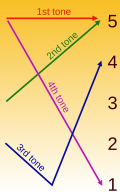

This article needs additional citations for verification. Please help improve this articlebyadding citations to reliable sources. Unsourced material may be challenged and removed.
Find sources: "Tone contour" – news · newspapers · books · scholar · JSTOR (December 2009) (Learn how and when to remove this message) |
Atone contourorcontour tone is a tone in a tonal language which shifts from one pitch to another over the course of the syllable or word. Tone contours are especially common in East Asia, Southeast Asia, West Africa, Nilo-Saharan languages, Khoisan languages, Oto-Manguean languages and some languages of South America.

When the pitch descends, the contour is called a falling tone; when it ascends, a rising tone; when it descends and then returns, a dippingorfalling-rising tone; and when it ascends and then returns, it is called a peakingorrising-falling tone. A tone in a contour-tone language which remains at approximately an even pitch is called a level tone. Tones which are too short to exhibit much of a contour, typically because of a final plosive consonant, may be called checked, abrupt, clipped,orstopped tones.
It has been theorized that the relative timing of a contour tone is not distinctive. That is, in some accents or languages a falling tone might fall at the end and in others it might fall at the beginning, but that such differences would not be distinctive. However, in Dinka it is reported that the phonemic falling tone falls late (impressionistically high level + fall, [˥˦˩]) while the falling allophone of the low tone starts early (impressionistically fall + low level, [˥˨˩]).[1]
Lexical tones more complex than dipping (falling–rising) or peaking (rising–falling) are quite rare, perhaps nonexistent, though prosody may produce such effects. The Old Xiang dialect of Qiyang is reported to have two "double contour" lexical tones, high and low fall–rise–fall, or perhaps high falling – low falling and low falling – high falling: ˦˨˧˨ and ˨˩˦˨ (4232 and 2142). The report did not determine if the final fall was lexical or merely the declination typically seen at the ends of prosodic units, so these may actually be dipping tones.[2]
This phonology article is a stub. You can help Wikipedia by expanding it. |